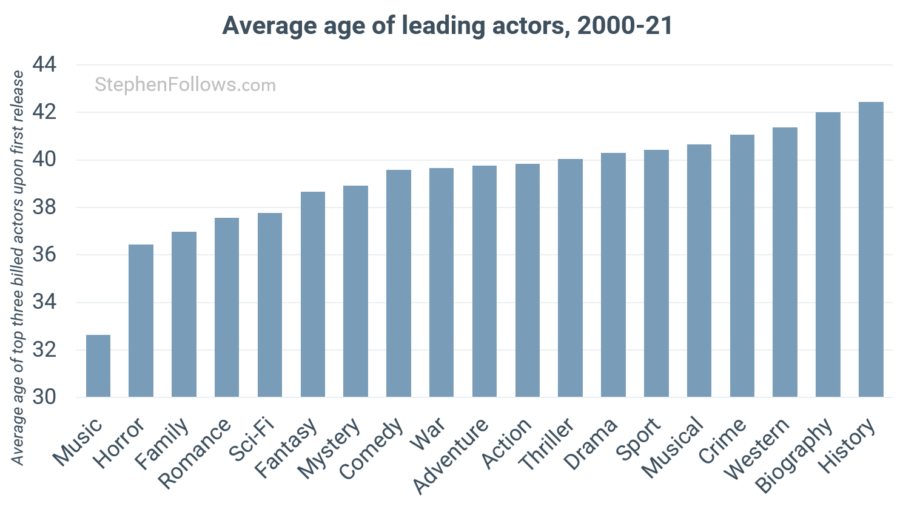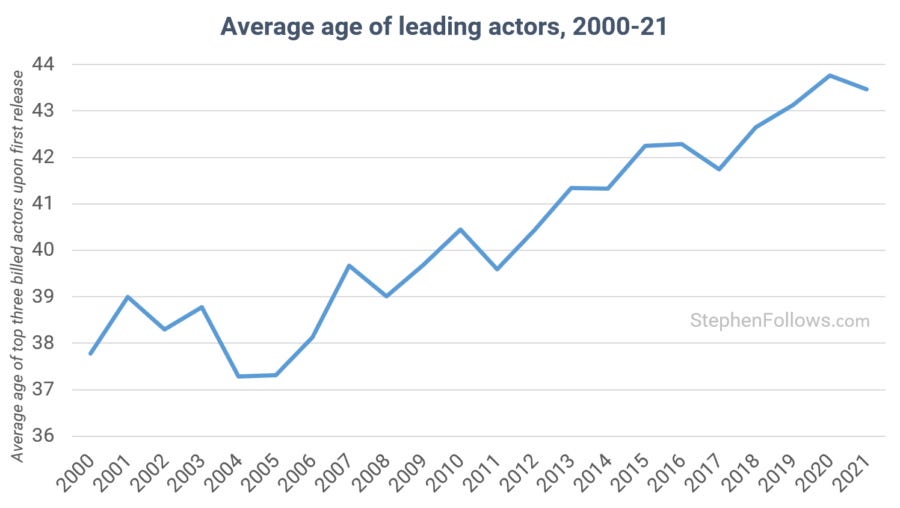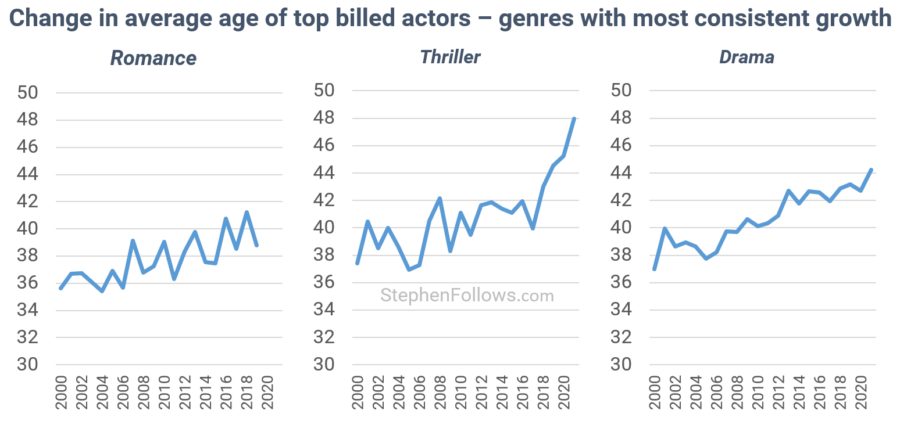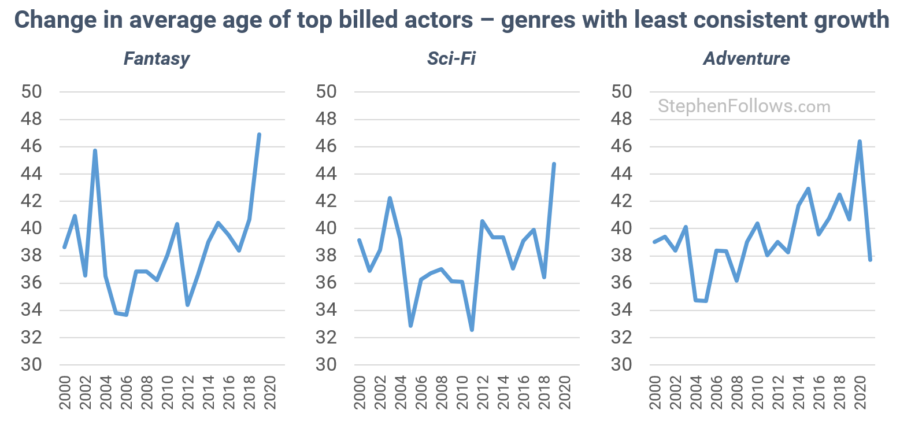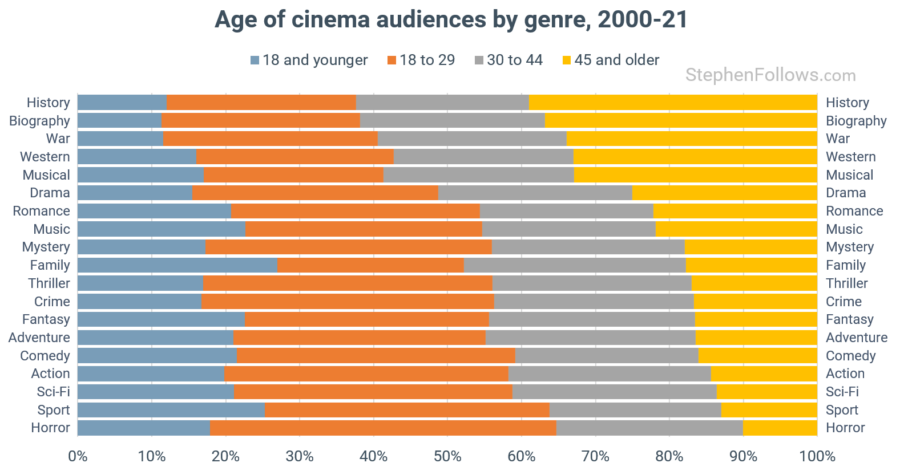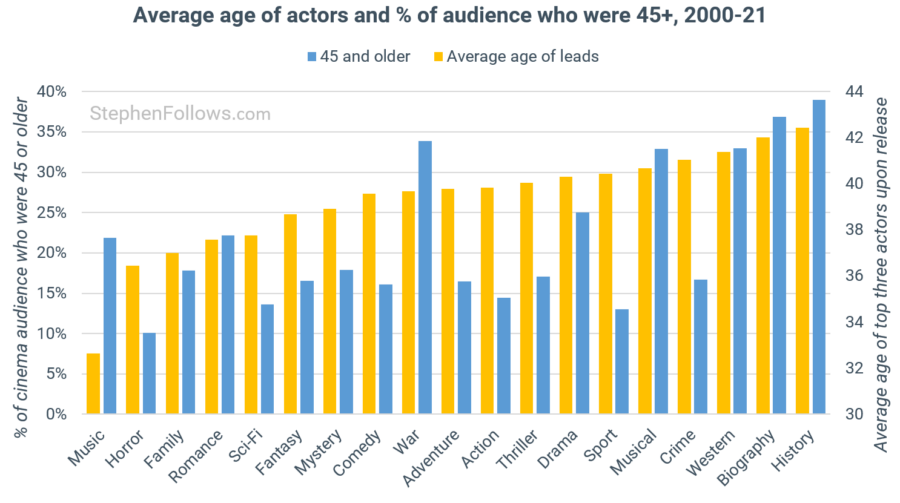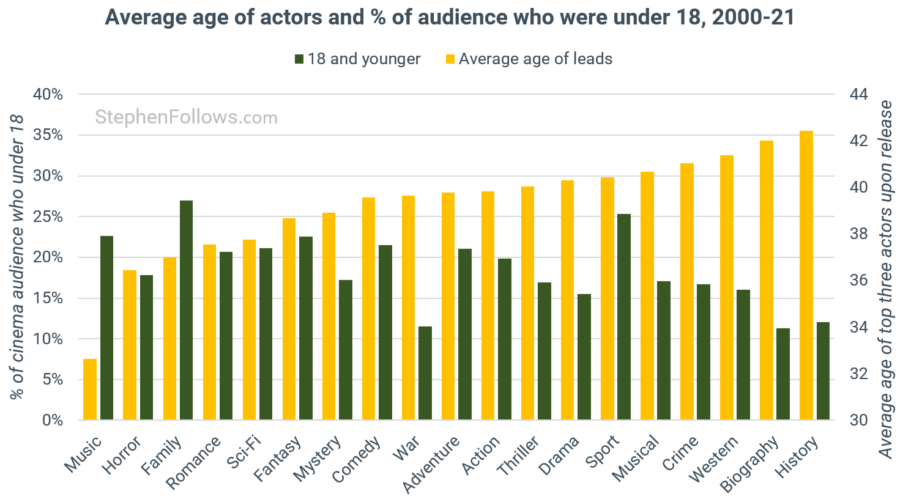Do older audiences want to watch older actors?
Today's topic comes from a reader. They are in pre-production and were challenged by a stakeholder on their casting choices.
The objection came from an experienced professional who said "My concern is that this film will play to an older audience and yet all your actors are young".
This prompted the filmmaker to get in touch with me to ask: "Is there a correlation between the age of the audience and the age of the lead actors in the films they chose to see?".
I love this question. It's one of those 'industry truths' that could go either way. On the one hand, it feels valid to suggest that people want to see themselves reflected in the heroes they choose to watch. On the other, when I think about my personal film choices I don't see an obvious skew towards people of my age.
Also, the industry loves passing along nuggets of 'wisdom' which sound neat but which are very rarely checked or evidenced (see a page of script equals a minute of screentime, cinemas only get 10% of box office, first-time directors are a risk, producers should know what they're doing, etc etc).
So let's see what the data can reveal on this question of the correlation between the age of actors and the age of audiences.
Let's start by looking at actors, after which we'll turn to audiences.
Acting your age
I focused on the top three billed actors of each movie and used public sources to find their date of birth on the day the film was first released.
Across all movies, the average age was 39.4. However, there was some significant variations between genres. Genres with the oldest actors were History (average age of 42.4), Biography (42) and Western (41.4), whereas the youngest actors were found in Music (32.6), Horror (36.5) and Family (37) films.
On a slight tangent from our main focus, I noticed that the average age of actors has been increasing for most of the past two decades.
In 2000, the average age of the three top-billed actors in movies in cinemas was 37.8. Twenty years later, in 2019, it had grown to 42.4, getting older by almost three months every year (i.e. Paul Rudd levels of ageing).
This effect was the strongest among Romance, Thrillers and Dramas.
And the genres with the least consistent growth were Fantasy, Sci-Fi and Adventure.
Anyway, back to our question about the link between actors' and audiences' ages.
How old are cinema audiences?
I've written a number of times in the past about the age of cinema audiences and even co-authored a couple of commissioned reports on the topic, so I won't go into too much detail here.
Suffice to say, that overall the cinema audience skews much younger than the general population, but recently we've seen a trend toward older audiences and away from younger cinema-goers.
Today's reader question was about older audiences so I shall focus on that segment.
For a long time, the film business regarded the oldest demographic subdivision imaginable as "45 years old to death" (albeit publicly they labelled this as simply "45+" for brevity and politeness). This reflects epic ageism, the focus on movies for younger audiences and the effect cinema advertisers have on audience data collection. Things are improving but we're stuck with the historic data we already have.
As the chart below shows, older audiences are most interested in watching Historical films (where 39% of the cinema audience have been 45 or older), Biographies (36.8%) and War (33.9%) films. There is a lot of overlap between films in these genres (i.e. most war films are historical and many are also biographies).
The genres with the fewest older patrons are Sci-Fi (13.6%), Sport (13%) and Horror (10.1%).
Ok, so now we know how old the lead actors are and how old the audiences are - let's see if they're correlated.
What's the correlation between the age of actors and audiences?
Our reader's question was: "Is there a correlation between the age of the audience and the age of the lead actors in the films they chose to see?"
To measure this precisely we can use the Pearson Coefficient, which gives us a number between -1 and 1 for any two groups of numbers, revealing how correlated they are. A score of one would indicate there is a perfect positive correlation (i.e. the older the actors, the older the audiences), minus one would be a perfect negative correlation and a score of zero would indicate no correlation.
The Pearson Coefficient between the average age of top-billed actors and the presence of older (i.e. 45+) audience members is 0.47. We would regard this as a moderate, positive correlation.
On the chart below, the average actors' ages are in yellow (right-hand axis), and the percentage of the audience who were 45 or older is in blue (left-hand axis).
Interestingly, there is a slightly stronger connection between the age of audiences and the presence of the youngest young members - a Pearson of -0.55. This might speak to the fact that when you cast older actors, not only are attracting older audience members but you're also dissuading younger patrons too.
There was no meaningful correlation between the age of actors and the presence of the middle two segments of audiences (i.e. 19 to 29-year-old and 30 to 44-year-olds).
So this suggests our reader should take into account the age of their audience in their casting choices, albeit to a moderate degree.
A somewhat neat answer, were it not for one thing... genre.
Just one more thing...
We have already seen how much of an effect genre has on people's choices, and we know that different genres tell stories of people of (slightly) different ages.
So, some of the effect we've just seen above could be more connected to the types of stories being told, rather than audience preference on the age of the characters within them.
This takes us to our final chart for today, and the one which reveals the fullest answer I can give to the question.
Below is the Pearson correlation for each genre. I have (semi-arbitrarily) used the colours to indicate what I think of as useful results. In the vast vast majority of genres, I don't think the age of the actors has much of an effect on the presence of older audience members (indicated in blue). The handful in orange do seem to have a stronger connection (most notably, Comedy, Music and Sport) and the one in red (Musical) which is negatively correlated.
This last chart suggests our reader should not worry too much about the age of their audience when thinking about who to cast.
The final word on this topic should be that the film industry is one of outliers. There are many trends, patterns or norms that 'mostly work most of the time', but which are then blown away by something new, different or lucky.
The role of business is to be consistent whereas the role of art is to bring something new to the table. The interplay of these two competing desires is where the true skill of filmmaking lies.
So today's result can only be broadly instructive, with the final call on each film being down to the key people involved in its creation and commercial exploitation.
Notes
Data for today's piece came from IMDb, Wikipedia, The Numbers and a number of other public and industry sources. Audience demographic data can be hard to find but is out there, usually in our sister industry of cinema advertising. Today's data relates to UK cinema audiences.
The release date is the North American theatrical release date, or when it first premiered on a first major platform (i.e. released during the pandemic). Given that films can take a year or two to create (more on that here), their age when shooting the movie will be slightly lower. Also, it's worth noting that an actor's 'playing age' might differ from their actual age (more on that here).
In the few cases where I only had a birth year for an actor, I went Korean and assumed they were born on the 1st of January. I found dates of birth for 67% of the eligible acting credits. I presume that those that were hard to find would skew younger, as it might reflect their lack of time in the public arena.
I excluded any data if there were fewer than ten movies in any slice (i.e. "romance films with audiences and age data released in 2021"). This also explains why I've not provided more granular genre-level data in some cases.
The pandemic has created a slightly unsolvable problem for film data analysis, in that for almost two years there was not the usual stream of new openings in cinemas. In order to compensate, the raw list of movies I sought to study was all movies which grossed at least $1 at North American cinemas between 2000 and 2019 inclusive, and all releases by the major studios in 2020 and 2021. This excludes movies made/acquired exclusively by streamers, unless they were theatrically released before 2020. Therefore, be extra cautious of trends you think you've spotted in the final couple of years in each temporal chart.
Epilogue
It's worth noting that the "average age of actors" is for movies for which I had both actors' ages and audience data, in order to make the correlations meaningful. This creates a slight skew towards bigger movies, given that the audience research is more often conducted for the types of movies cinema advertisers are interested in.
I re-ran the numbers for all movies, regardless of audience data available, in order to check the effect this was having. Across all movies, the average age of actors was 39.4 for movies with audience data and 40.0 for all movies regardless of audience data.
The only genre where this difference seemed to actually matter was musicals, where the average was 40.7 and 37.1 respectively. I suspect this is just the effect of a small number of musicals but could also be read as smaller / indie musicals casting older actors.
More research is needed here - let me know if it's of interest and I'll look at it in a future research project.



